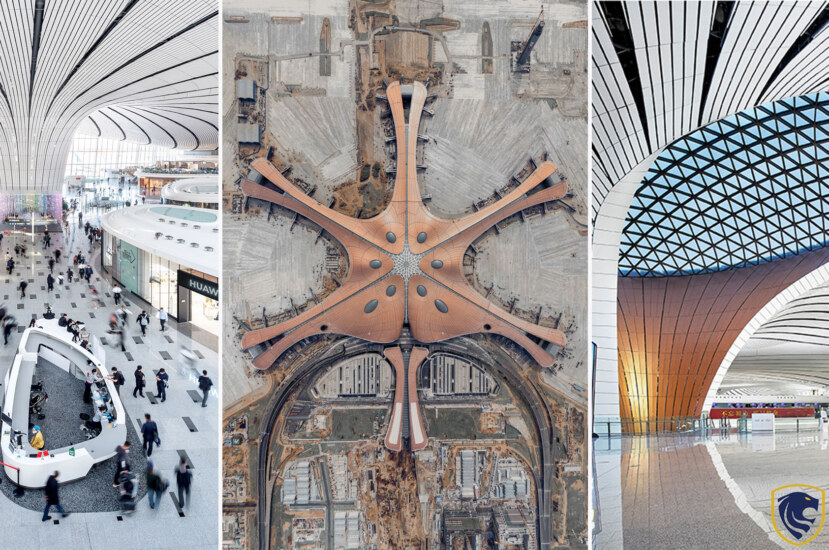Beijing has two international airports. One of them is Beijing Capital International International Airport. And the other one is Beijing Daxing International Airport. It is situated between Beijing and Langfang, in the province of Hebei. It is known as “the starfish.” On September 26, 2019, it started operating after being finished on June 30, 2019.
The airport, which services Beijing, Tianjin, and Hebei, is located 46 km (29 mi) south of Tiananmen Square. While Hainan Airlines and the majority of Star Alliance members have stayed at Beijing Capital International Airport, it serves as a hub for SkyTeam alliance carriers and selects One world members.
The CN$80 billion complex, which took nearly five years to complete, is the biggest single-building airport terminal in the world at 700,000 m2 (7,500,000 sq ft). Moreover, it occupies 47 km2 (18 sq mi) of space. The airport was recognized by Airports Council International with awards for top hygienic practices and best in size and region in 2020. Furthermore, for both honors plus Voice of the Customer in 2021.
Constructions
Early media reports from September 2011 indicated that the proposed airport might have up to nine runways. Eight of them were for general aircraft and one for military use. It would take over as Beijing’s primary airport. Moreover, was intended to replace Beijing Capital International Airport, which had 83 million passengers in 2013 and ranked second in the world, as the busiest airport in China. A 120–200 million passenger annual potential was planned for the airport. On December 22, 2014, the National Development and Reform Commission officially approved the construction.

Constructions
At the boundary between Beijing and Hebei Province, in the southern section of Beijing’s Daxing District, an airport was to be built, according to the plan. As a result of continuing talks, no design or plans were made public. Moreover, according to the information provided, there would be 7 runways. 6 of them were for civilian usage and 1 for military operations. As of September 2019, construction was complete. Also, by 2025, it will be able to accommodate 75 million people. The initial estimate for the project’s price was at least 70 billion RMB.
Design and architecture of Beijing Daxing International Airport
One of the biggest airports in the world, Beijing Daxing International Airport, now features a five-pronged terminal complex designed by Zaha Hadid Architects .The 700,000 square meter terminal serving Beijing was designed by the late Zaha Hadid. Also, he was accompanied by current firm principal Patrik Schumacher, working with airport expert ADPI, to be as small as feasible. Further, Five aircraft piers radiate out from the airport’s center “great courtyard,” giving the structure the appearance of a starfish from above. The core area, which is naturally illuminated and has a glass top that the studio describes as a “central orientation space dome,” is surrounded by a four-story airport.

Design and architecture of Beijing Daxing International Airport
Within this center, the area is the international and domestic security checkpoints. Also, the domestic shopping area and the check-in island are located here. The layout of the terminal “exactly directs all passengers through the proper departure, arrival, or transfer zones.” The core of the terminal is a multi-layered gathering room with a large plaza at its center. In addition, Chinese traditional architecture arranges connected areas around a main courtyard. Around the five aircraft docks, there are 79 gates where passengers may board planes.
Each of which has an airbridge leading directly to the terminal. The studio claims that this is the most effective setup for helping lots of people get to their flights fast. “The terminal’s tiny radial shape allows the largest amount of aircraft to be parked instantly at the terminal with the shortest ranges from the building’s center. Excellent passenger convenience and operational flexibility are being provided by this. ” Furthermore, this radial arrangement makes it possible to walk to the farthest boarding gate in less than eight minutes.
sixth radiating arm

architecture of Beijing Daxing International Airport
The 80,000 square meter transportation center is located on a sixth radiating arm and includes a hotel and offices. In addition, there are local and high-speed rail stations.
The airport is powered by solar panels and features a ground-source heat pump-supported central heating system that recovers waste heat. Moreover, a rainwater collecting and management system has been installed.
Sustainable features
Beijing Daxing Airport uses energy-saving innovative green techniques to let natural sun light into the structure. Around 10% of the electricity used by the airport is generated by renewable sources. Furthermore, the aerodynamic roof has incorporated environment control technology to reduce energy consumption and skylights to maximize heat from the sun.
The airport has a solar farm that can produce 10MW of electricity thanks to photovoltaic cells put on the roofs of the hangars, car parks, and cargo facilities.

Beijing Daxing International Airport.
Beijing Daxing’s central heating system is supported by a combined ground-source heat pump system and waste heat recovery systems, with a concentrated energy supply area of around 2.5 million m2. In order to meet the facility’s resource and energy demands, a 100% rain water storage system was put in place.
Geothermal heat pumps in the basin of the Yongding River supply the airport’s heating and cooling systems. 8% of the airport’s energy needs are anticipated to be satisfied by the energy from the pumps. Filter glasses are employed to keep the terminal building’s interior 60% cool and 60% lit by natural sunshine.
Facilities at the Beijing Daxing International Airport
The airport’s landside terminal, which is run by China Resources Land, has showrooms, interactive pet hotels, and hybrid online eating and shopping locations. It also contains a daycare center and a nursery. Furthermore, it has 79 gates that are connected to the terminal via air bridges. Together with other members of the SkyTeam Airline Alliance, China Southern Airlines and China Eastern Airlines fly out of Daxing Airport.

Facilities at the Beijing Daxing International Airport
The KNX building control system includes DALI drivers and a light management system in the terminal. It has T-Systems systems installed, which safely digitalize all airport operations. Moreover, it has 174 KONETM Travel Master escalators as well as the KONE E-LinkTM remote elevator monitoring system. Inquiry robots are another component of the terminal.
Radiofrequency identification devices are used at the airport for tracking luggage. Moreover, face recognition is used to ensure safe entrance of the passengers. The terminal’s enormous size and numerous residents make an emergency escape a significant difficulty. The Central zone’s escape distance is over 200 meters, although it should only be 75 meters. The Central zone has 29 egress stairs in total, which assist reroute passenger flow and avoiding bottlenecks while also cutting down on this distance on various levels.




